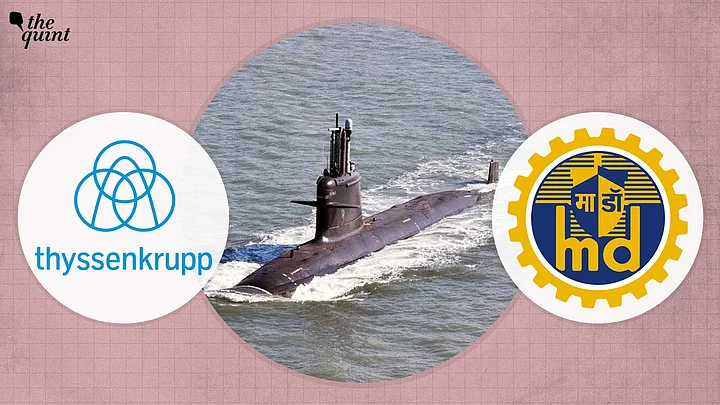A Memorandum of Understanding (MoU) was signed in Mumbai on Wednesday, 7 June, between India’s premier shipbuilding yard, Mazagon Docks Ltd (MDL), and the German shipbuilder ThyssenKrupp Marine Systems (TKMS) to collaborate in building state-of-the-art submarines in India as part of the long-delayed P-75I project, or Project-75.
It marks incremental progress in augmenting the Indian Navy’s shrinking underwater platform capability. It is significant that the MoU was signed in the presence of the German Defence Minister Boris Pistorius who was on his first visit to India.
It may be inferred that this kind of visible political support by Germany, even at a preliminary level of cooperation with an Indian entity in the defence sector, is a reflection of the change in Berlin’s orientation towards Asia in general and Delhi in particular. In the post-unification decades, Germany kept their focus on Asia, and their engagement was primarily with China. India had a modest relevance in Berlin’s larger strategic calculus.
Why is The Memorandum Important?
The current MoU will enable MDL and TKMS to jointly bid for the Rs. 45,000 crores Indian project to build modern conventional diesel boats (as the submarines are referred to) with air-independent propulsion (AIP) features, which will enhance the inherent stealth characteristics of the underwater platform.
The most critical determinant in the signing of the MoU is the traction it will provide in enabling India to acquire the much-needed addition to its dwindling conventional submarine force. While a total of 24 such boats had been envisioned under the Navy's 30-year submarine-building plan, the number is now down to 16 and most of them are in the vintage category. The correlation with India's sea-denial capability is self-evident.
The proposal to build these boats in India has a chequered past and there is a German footprint that merits discussion. However, this requires a recap of the long-delayed P-75I project. Initially conceived in the Vajpayee years, the government decided to give approval, in principle, for India to build six boats at an Indian yard with a foreign supplier in 1999.
It is a reflection of the long and complex procedural delays that plague major Indian defence acquisition programs, taking 24 years (from 1999 to 2023) for the 75I to slowly move further - but even this is tentative.
This submarine project is part of the Strategic Partnership (SP) flagship programs that the Ministry of Defence has prioritised (the other three being fighter aircrafts, helicopters and armoured vehicles). In this scheme, an Indian entity has to partner with a foreign entity and make a joint bid. Thereafter, the government would, after a long and tedious process, arrive at a final determination that would be based on techno-commercial and design/manufacturing know-how transfer considerations.
What India's History with Submarines Shows Us
This can be very challenging, as the recent experience with France has shown in the Scorpene submarine project. It may be noted that the Indian Navy has acquired its conventional submarines in the past: the first from the USSR (now Russia) in 1967, later from West Germany in 1986, and most recently from France.
While Moscow had not encouraged the transfer of submarine manufacturing knowledge that would have enabled India to build conventional boats in its own yards, the West German experience marks a high point in this domain. With Prime Minister Rajiv Gandhi in the chair, India signed a contract to acquire four HDW (Howaldtswerke-Deutsche Werft) 209 boats from then West Germany. The first two were to be built in Kiel and the last two in Mumbai.
Accordingly, India invested a substantial amount of money in creating a new submarine manufacturing facility in MDL, and a workforce of civilian and naval personnel were trained for this ambitious task.
Regrettably, the HDW project was mired in a maze of scandals – wherein, financial transgressions and alleged political culpability resulted in the government of the day making an impulsive and feckless decision: Delhi imperiously scuttled the submarine building project. In this author’s view, this hasty closure was a huge strategic blunder, and a major setback to the nascent, indigenous submarine building effort.
The Pistorius visit could provide an opportunity for Delhi to arrive at an objective determination to identify Germany as a defence manufacturing partner of proven credibility in the long term, and for the 'atmanirbhar’ (self-reliance) goal to be realised in the domain of shipbuilding.
The Way Forward
The experience with the four HDW boats, called the Shishumar class, has been very positive for the Indian Navy.
These platforms were commissioned in the period from 1986 to 1994, and are now in their fourth decade of service. Their maintenance and repairs over the years, including the Medium Refit and Life Certification (MRLC) have been done in India. This is testament to the quality of technical documentation and knowledge provided by the German supplier in the initial contract period.
In contrast, most of the submarines acquired from Moscow have gone back to Russia (erstwhile USSR) for similar refurbishment, and the contrast is instructive.
The final decision as to who the winner will be in the bids for 75I is yet to be taken. It is likely that there will be intense, no-holds-barred competition among the various participants (Indian entities and their foreign partners) including the MDL-TKMS combine. It is hoped that this process will be accelerated, and unaffected by the Indian electoral cycle.
Setting an objective that the first indigenous 75I boats will be commissioned by the end of 2030 would be highly laudable.
(Commodore C Uday Bhaskar, Director, Society for Policy Studies, has the rare distinction of having headed three think tanks. He was previously Director at the National Maritime Foundation (2009-11) and the Institute for Defence Studies and Analyses (2004-05). He tweets @theUdayB. This is an opinion piece. The views expressed above are the author’s own. The Quint neither endorses nor is responsible for them.)
